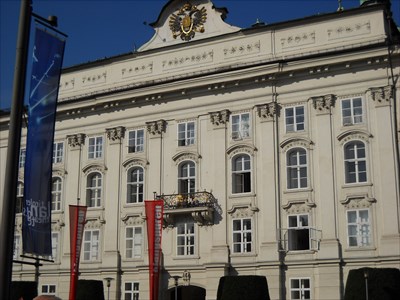
 The Imperial Palace was completed in the year 1500 under Emperor Maximilian I (1459-1519). The palace was built to the same scale as is seen today and was captured as a watercolour by Albrecht Dürer.
The Imperial Palace was completed in the year 1500 under Emperor Maximilian I (1459-1519). The palace was built to the same scale as is seen today and was captured as a watercolour by Albrecht Dürer.
The painting shows a late Gothic courtyard with covered staircase, a Crest Tower and the women’s quarters (or “women’s rooms”). The reception area, which is known today as the “Gothic Cellar”, was built in the style of a large hall with columns and vaults. A “Kürnstube” (home to Maximilian’s hunting trophies), the “Silver chamber” (treasury) and the Festival Hall (with depictions of Hercules) are also reminders of the time.
Almost 250 years later, Maria Theresa (1717-1780) visited the Innsbruck palace and deemed it to be behind the times. There hadn’t been any Tyrolean princes since 1665 and the governor, who reigned Tyrol on behalf of the Emperor, lived in the governor’s quarters on the first floor.
The representation rooms on the second floor, which were reserved for the Imperial family, were uninhabited. Maria Theresa arranged for the palace to be rebuilt in the Viennese late Baroque style and sent her best artists to Innsbruck: Konstantin von Walter and Nicolaus Parcassi.
Martin van Meytens and his school and Franz Anton Maulbertsch were appointed for the interior. The renovations were interrupted by the Seven Years’ War and, therefore, only completed in the 1770s.
Following the end of the monarchy (1918), former Imperial possessions became state property. Today, the Imperial Palace is the third most important historic building in Austria and is managed by the Burghauptmannschaft.
The third and final part of the general restoration works was completed between 2006 and 2010. The palace is frequently used for high-profile events.
Sources : The Castle


 Le Palais impérial (Hofburg) dans sa taille actuelle fut achevé en 1500, sous l'empereur Maximilien Ier (1459-1519). Ce fut l'aboutissement d'un vaste ouvrage de transformation et d'agrandissement des constructions successives réalisées, 100 ans durant, par les souverains du Tyrol, pour former un tout.
Le Palais impérial (Hofburg) dans sa taille actuelle fut achevé en 1500, sous l'empereur Maximilien Ier (1459-1519). Ce fut l'aboutissement d'un vaste ouvrage de transformation et d'agrandissement des constructions successives réalisées, 100 ans durant, par les souverains du Tyrol, pour former un tout.
On y admire une cour de style gothique flamboyant avec un escalier couvert, la tour aux armoiries et les appartements appelés « chambres des dames ».
Il y avait également une vaste salle de réception avec des colonnes et des voûtes - la « cave gothique » d'aujourd'hui. L'existence d'une « Kürnstube » pour accueillir les trophées de chasse de Maximilien, d'une « chambre d'argent » (salle du trésor) et d'une salle des fêtes (avec des fresques herculéennes) est également attestée.
Presque 250 ans plus tard, l'impératrice Marie-Thérèse (1717-1780) se rendit en son château innsbruckois et le trouva fort peu au goût du jour.
Depuis 1665, il n'y avait plus de princes du Tyrol, mais des gouverneurs dépêchés par l'empereur depuis Vienne; ils demeuraient au premier étage (gouvernorat). Les salles de représentation au deuxième étage, réservées à la famille impériale, restaient inhabitées.
La monarque ordonna une rénovation dans le style rococo viennois et envoya ses meilleurs artistes à Innsbruck : Constantin Johann Walter et Nicolò Pacassi.
L'aménagement intérieur fut confié à Martin van Meytens et ses élèves ainsi qu'à Franz Anton Maulbertsch. Cette vaste refonte du Palais impérial fut interrompue par la guerre de Sept Ans, de sorte qu'elle ne fut achevée que dans les années 1770.
Avec la fin de la monarchie (1918), le bien impérial passa aux mains de la République autrichienne. Les Monuments nationaux d'Autriche (Burghauptmannschaft) assurent la gestion de ce qui est le troisième monument historique le plus important d'Autriche.
Entre 2006 et 2010, la troisième et dernière partie de la rénovation générale du Palais impérial fut achevée. De nos jours, la « Hofburg » accueille très régulièrement des événements prestigieux.
Sources : Le Château


 Im Jahre 1500 war die Hofburg Innsbruck unter Kaiser Maximilian I. (1459-1519) fertig gestellt worden. Sie hatte bereits dieselben Ausmaße wie heute und wurde von Albrecht Dürer als Aquarell festgehalten.
Im Jahre 1500 war die Hofburg Innsbruck unter Kaiser Maximilian I. (1459-1519) fertig gestellt worden. Sie hatte bereits dieselben Ausmaße wie heute und wurde von Albrecht Dürer als Aquarell festgehalten.
Darauf erkennt man einen spätgotischen Innenhof mit überdachtem Treppenaufgang, den Wappenturm und die Frauengemächer, "Frauenzimmer" genannt. Es gab einen großen Empfangsraum, welcher als Halle mit Säulen und Gewölbe gestaltet war und heute als "Gotischer Keller" bezeichnet wird.
Eine "Kürnstube", in welcher die Jagdtrophäen Maximilians untergebracht waren, eine "Silberkammer" (Schatzkammer) sowie ein Festsaal (mit Herkulesdarstellungen) sind ebenfalls überliefert.
Fast 250 Jahre später besuchte Maria Theresia (1717-1780) die Kaiserliche Hofburg Innsbruck und empfand diese nicht mehr zeitgemäß. Seit 1665 gab es keine Tiroler Landesfürsten mehr und die Statthalter, welche nun im Auftrag des Kaisers Tirol regierten, bewohnten das erste Stockwerk (Statthalterei).
Die Repräsentationsräume im zweiten Obergeschoss, welche der Kaiserlichen Familie vorbehalten waren, blieben unbewohnt. Die Herrscherin ordnete einen Umbau im Stil des Wiener Spätbarocks an und schickte ihre besten Künstler nach Innsbruck: Konstantin von Walter und Nicolaus Parcassi.
Zur Innenausstattung wurden Martin van Meytens und seine Schule sowie Franz Anton Maulbertsch bestellt. Die Umbauarbeiten wurden durch den Siebenjährigen Krieg unterbrochen, sodass sie sich bis in die 70er Jahre des 18. Jahrhunderts hinzogen.
Mit Ende der Monarchie (1918) wurde der ehemals kaiserliche Besitz staatlich. Die Burghauptmannschaft verwaltet heute das drittwichtigste historische Gebäude Österreichs.
Während der Jahre 2006-10 wurde der dritte und letzte Teil der Generalsanierung der Hofburg fertiggestellt. Sie wird häufig für hochrangige Veranstaltungen genutzt.
Sources : Das Schloss